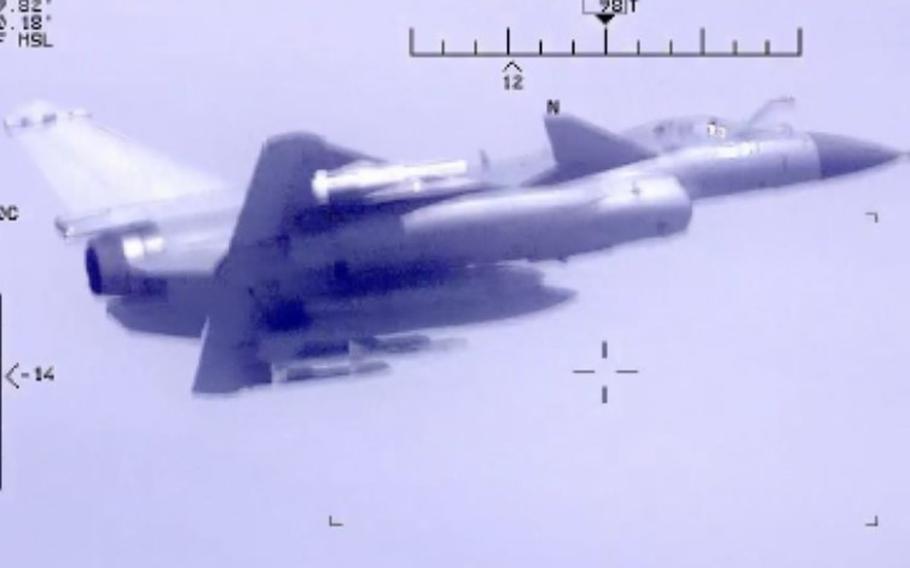
Images and video newly released by the Defense Department capture a Chinese fighter jet in the course of conducting a coercive and risky intercept against a lawfully operating U.S. asset in the East China Sea. Over the course of five hours, four Chinese aircraft conducted this intercept, at one point reaching a distance of just 75 feet from the U.S plane. (Defense Department)
WASHINGTON — There has been a sharp increase in risky behavior by Chinese pilots in the South China Sea in the past two years, U.S. defense officials said Tuesday, releasing newly declassified images and video to support their claim.
“Since the fall of 2021, we have seen more than 180 such incidents — more in the past two years than in the decade before that,” said Ely Ratner, the Pentagon’s assistant secretary of defense for Indo-Pacific security affairs. “That’s nearly 200 cases where [Chinese] operators have performed reckless maneuvers, or discharged [anti-radar measures], or shot off flares, or approached too rapidly or too close to U.S. aircraft.”
Ratner said the number of risky midair incidents rises to at least 300 since 2021 when accounting for Chinese actions against U.S. and ally planes in the South and East China Sea.
“All [this is to try] to interfere in the ability of U.S. forces to operate safely in places where we and every country in the world have every right to be under international law,” he said.
Ratner and Adm. John Aquilino, the commander of Indo-Pacific Command, expressed alarm at the abrupt rise in “risky and coercive” maneuvers and said they will be outlined in more detail in the Pentagon’s forthcoming Chinese Military Power Report — the Defense Department’s annual assessment of Beijing’s military strength.
“This year’s report will be out soon and taken together with today’s announcements, it represents the department’s most comprehensive depiction to date of this highly concerning behavior by the [Chinese military],” Ratner said. “[China’s] coercive and risky behavior … seeks to intimidate and coerce members of the international community into giving up their rights.”
Chinese military aggression against U.S. and allied aircraft in the region is nothing new. The Pentagon has noted multiple incidents this year, including one in May when a Chinese fighter jet made an “unnecessarily aggressive maneuver” in flying too close to a U.S. reconnaissance plane over the South China Sea.
Ratner and Aquilino said the images released Tuesday showing the risky behavior by Chinese planes were only just declassified. They said the increasingly unsafe behavior by China could lead to “inadvertent conflict.”
“I am most concerned about the potential for accidents, and those accidents could lead to miscalculation,” said Aquilino, PACOM’s commander since May 2021. “We must prevent these from happening.”
For example, the Pentagon officials said an American plane was flying safely and lawfully over the South China Sea when it was approached by a Chinese fighter jet flying “hundreds of miles per hour.” They said the Chinese jet was clearly armed and came within 30 feet of the U.S. plane.
“In fact, once it was there, the [Chinese] fighter jet lingered at that narrow proximity for more than 15 minutes,” Ratner said, adding the incident occurred just weeks after a similar intercept. He said the repeated incidents indicate a “central and concerted campaign” of aggression on China’s part.
China has one of the most sophisticated militaries in the world and has long been considered an increasing threat in the region, particularly to Taiwan. Beijing has long considered Taiwan a breakaway territory, and Chinese leaders have long expressed a desire to “unify” with the island at some point.
Army Gen. Charles Flynn, the commander of U.S. Army Pacific, said recently that China could be considering the late 2020s as a time to undertake an invasion of Taiwan, which is located only about 115 miles east of mainland China. Last fall, the Defense Department said in its National Defense Strategy that China, due to its military strength, is the No. 1 global “pacing challenge” for the United States.
In the past, China has denied accusations of reckless behavior on and over the South China Sea — mainly because it claims ownership over much of the sea, which also borders parts of the Philippines, Indonesia and Vietnam. The East China Sea is farther to the northeast and borders China, Japan and South Korea. Because China claims ownership over much of the seas, it challenges the rights of other countries to fly or sail there.
Ratner said the recent risky Chinese behavior also has included incidents on the water, and the most recent aggression occurred last month.
“Every one of these is one too many,” he said.